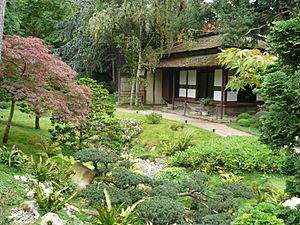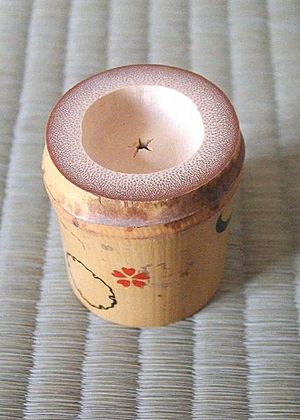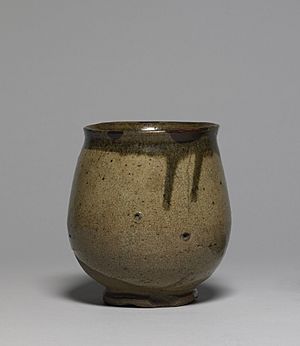Japanese tea ceremony facts for kids
The Japanese tea ceremony is a special and beautiful way to make and serve green tea. It is also known as cha-no-yu, chado, or sado. People often call it the "Way of Tea." This ceremony is an important part of Japanese culture. It involves carefully preparing and presenting a special powdered green tea called matcha. Learning the tea ceremony takes a lot of practice. Students also learn about different teas, kimono (traditional Japanese clothes), and Ikebana (flower arranging).
Contents
The Story of Tea in Japan
Tea first arrived in Japan from China around the year 900 CE. It quickly became very popular. Soon, Japanese people started growing their own tea plants.
In the 12th century, a special kind of powdered green tea called matcha became popular. This tea comes from the same plant as black tea.
By the 16th century, everyone in Japan enjoyed drinking tea. This included both rich and poor people. A famous man named Sen no Rikyu began teaching the tea ceremony. Even today, people still make tea in a way similar to what Sen no Rikyu taught. There are different schools of tea ceremony, like omote-senke and ura-senke. Each school has its own slightly different way of performing the ceremony.
Tools for the Tea Ceremony
People need many special items for a tea ceremony. Each tool has a specific name and purpose.
- Tea bowl (called chawan). People drink tea from these bowls instead of cups. Some of the bowls used are over 400 years old.
- Tea scoop (called chashaku). This is a spoon made from bamboo. It is used to put tea powder into the tea bowl. Larger scoops are used to put tea into the tea caddy.
- Whisk (called chasen). This tool looks like a brush made from bamboo. It is used to mix the tea powder with hot water.
- Tea caddy (called natsume or cha-ire). This is a special container for the green tea powder. There are two main types. A natsume is short with a flat lid and a round bottom. It is made of wood. Sometimes it is called cha-ki. A cha-ire is tall and thin, made of ceramic. Different ceremonies use different caddies. Natsume is for weak tea (usu-cha), and cha-ire is for strong tea (koi-cha).
- Napkin (called fukusa). This is a square cloth made of silk. It is used to symbolically clean the tea scoop and tea caddy.
- Ladle (called hishaku). This ladle is made of bamboo. It has a cup-like part attached to a long handle.
- Water jar (called mizusashi). This jar holds fresh water. It is used to add water to the iron pot after tea has been made.
- Waste-water container (called kensui). This container holds the water used to wash the tea bowl and whisk. This washing happens before and after making tea.
- Iron pot (called kama). The kama holds hot water. During the ceremony, charcoal keeps the water boiling.
- Tea (called matcha). This is powdered green tea. During the ceremony, it is mixed with hot water using a whisk to make a drink.
How the Ceremony Works
The tea ceremony usually takes place in a special tea room or a building called a cha-shitsu. Most people wear traditional kimonos.
When guests enter the tea room, they take off their shoes. Then they sit on special floor mats called tatami. Tea rooms are often quite small and simple. Sometimes, guests might eat a small meal or drink Japanese wine called sake. Before drinking the green tea (matcha), they always eat something sweet.
The host, who performs the ceremony, symbolically cleans the tea bowl and other tools. Then, they put some green tea powder into the tea bowl. The host mixes the tea with hot water using a whisk. Guests then drink the tea from the bowl.
Once everyone has finished drinking tea, the host cleans all the tools and puts them away. After this, the guests leave. A tea ceremony can last from about twenty minutes to around four hours.
Images for kids
-
Woman wearing kimono prepares tea
-
Maiko preparing teacups
-
Master Sen no Rikyū, who codified the way of tea (painting by Hasegawa Tōhaku)
-
An open tea house serving matcha (ippuku issen (一服一銭), right) and a peddler selling extracts (senjimono-uri (煎じ物売) left), illustration from Shichiju-ichiban shokunin utawase (七十一番職人歌合), Muromachi period; Ippuku issen's monk clothing depicts the relationship between matcha culture, tea offerings, and Buddhism
-
Tea utensils used by Urasenke iemoto Sen Sōshitsu XV
-
Guests seated to receive tea (print by Yōshū Chikanobu)
-
A small wagashi sweet served on an Oribe ware plate, next to an Ido ware chawan filled with green matcha
-
Tea ceremony performed by Genshitsu Sen, 15th Grand Master of the Urasenke school
-
A set of sencha utensils, Sasashima ware, Maki Bokusai, Edo period, 18th–19th century
Related pages
- Tea ceremony
English books about the ceremony
- Okakura Kakuzo. The Book of Tea. Tokyo, Japan: Tuttle, 1977.
- Tanaka, S. The Tea Ceremony. New York: Harmony Books, 1977.
- Morgan Pitelka, ed. Japanese Tea Culture: Art, History, and Practice. London: RoutledgeCurzon, 2003.
- Sadler, A.L. Cha-No-Yu: The Japanese Tea Ceremony. Tokyo: Tuttle, 1962.
- Freeman, Michael. New Zen: the tea-ceremony room in modern Japanese architecture. London, 8 Books, 2007
See also
 In Spanish: Ceremonia del té japonesa para niños
In Spanish: Ceremonia del té japonesa para niños






























